Preparation and Properties of Carbon Fiber/Flexible Graphite Composite Grounding Material
Abstract
:1. Introduction
2. Experimental Details
2.1. Materials
2.2. Preparation of Flexible Graphite Ground Materials
2.3. Preparation of Flexible Graphite Ground Material Coupled with Metal
2.4. Characterization
3. Results and Discussions
3.1. Micromorphology of the Composite Conductive Material
3.2. Mechanical Properties of the Composite Conductive Material
3.3. The Volume Resistivity of the Composite Conductive Material
3.4. Influence of High- and Low-Temperature Conditions on the Properties of Composite Materials
3.5. Corrosion Mechanism of Composite Conductive Material
3.6. Morphology Analysis of Corrosion Products
3.7. XRD Analysis of Corrosion Products
4. Conclusions
Author Contributions
Funding
Institutional Review Board Statement
Informed Consent Statement
Data Availability Statement
Acknowledgments
Conflicts of Interest
References
- Souto, L.; Taylor, P.C.; Wilkinson, J. Probabilistic impact assessment of lightning strikes on power systems incorporating lightning protection design and asset condition. Int. J. Electr. Power Energy Syst. 2023, 148, 108974. [Google Scholar] [CrossRef]
- Hu, H.; Luo, R.; Fang, M.; Zeng, S.; Hu, F. A new optimization design for grounding grid. Int. J. Electr. Power Energy Syst. 2019, 108, 61–71. [Google Scholar] [CrossRef]
- Liu, K.; Zhang, S.; Li, B.; Zhang, C.; Liu, B.; Jin, H.; Zhao, J. Flexible grounding system for single-phase to ground faults in distribution networks: A systematic review of developments. IEEE Trans. Power Deliv. 2021, 37, 1640–1649. [Google Scholar] [CrossRef]
- He, J.; Zeng, R.; Zhang, B. Methodology and Technology for Power System Grounding; John Wiley & Sons: Hoboken, NJ, USA, 2012. [Google Scholar]
- Song, L.; Zhang, C.; Zhao, J.; Yang, R.; Yuan, Y. Influence of Current on Soil Corrosion of Galvanized Steel of Grounding Grids. Micromachines 2022, 13, 190. [Google Scholar] [CrossRef]
- Ezzeldin, I.; El Naggar, H.; Newhook, J.; Jarjoura, G. Accelerated wet/dry corrosion test for buried corrugated mild steel. Case Stud. Constr. Mater. 2022, 17, e01152. [Google Scholar] [CrossRef]
- Lu, J.Z.; Yang, L.; Zhang, H.X.; Fang, Z.; Li, B.; Jiang, Z. Application of ion earthing electrode and anti-corrosion synthetical reconstruction technique in reconstruction of grounding grids. In Proceedings of the 2011 7th Asia-Pacific International Conference on Lightning, Chengdu, China, 1–4 November 2011; IEEE: Piscataway, NJ, USA, 2011; pp. 562–566. [Google Scholar]
- Huang, Y.; Zheng, Z.; Fu, Z.; Zhang, Y.; Xu, J.; Chen, S.; Zhang, H. Electrochemical corrosion behavior of Ti-3Mo alloy under different accelerated corrosion tests. Mater. Corros. 2022, 73, 1888–1899. [Google Scholar] [CrossRef]
- Zhao, J.; Meng, X.; Ren, X.; Li, S.; Zhang, F.; Yang, X.; Xu, J.; Yuan, Y. Review on Soil Corrosion and Protection of Grounding Grids. Materials 2024, 17, 507. [Google Scholar] [CrossRef] [PubMed]
- Zhang, C.; Liao, Y.; Gao, X.; Zhao, J.; Yuan, Y.; Liao, R. Research advances of soil corrosion of grounding grids. Micromachines 2021, 12, 513. [Google Scholar] [CrossRef]
- Fan, P.; Chen, H.; Zheng, J.; Yu, X.; Gong, W. Analysis of Failure Causes of Grounding Flat Steel for 110kV Transmission Tower. J. Phys. Conf. Ser. 2022, 2378, 012031. [Google Scholar] [CrossRef]
- Tang, K.; Ruan, J.; Huang, D.; Xiao, W.; Li, H. Application study of flexible graphite grounding electrode in typical tower grounding grid. In Proceedings of the 2016 IEEE International Conference on High Voltage Engineering and Application (ICHVE), Chengdu, China, 19–22 September 2016; IEEE: Piscataway, NJ, USA, 2016; pp. 1–4. [Google Scholar]
- Wang, R.; Yang, H.C.; Lv, Y.; Xu, Z.Y.; Gao, Y. A Research and the Application of a New Graphite Grounding. Adv. Mater. Res. 2013, 614, 1348–1351. [Google Scholar] [CrossRef]
- Hu, Y.; Ruan, J.; Gong, R.; Liu, Z. Flexible graphite composite electrical grounding material and its application in tower grounding grid of power transmission system. Power Syst. Technol. 2014, 38, 2851–2857. [Google Scholar]
- Huang, D.; Xia, J.; Ruan, J.; Wu, Y.; Quan, W. Characteristics of the flexible graphite grounding material and its engineering application. IEEE Access 2019, 7, 59780–59787. [Google Scholar] [CrossRef]
- Huang, T.; Hu, Y.; Xie, H.; Du, C.; An, Y.; Shen, W.; Liu, Z.; Cheng, M. A New Flexible Graphite Composite Electrical Grounding Material. Front. Mater. 2022, 9, 825694. [Google Scholar] [CrossRef]
- Liu, L.; Li, J.; Peng, M.; Li, W.; Lei, B.; Meng, G. Macro-galvanic corrosion of tower grounding device consisting of graphite and Zn-coated steel in a simulated soil environment. Eng. Fail. Anal. 2022, 135, 106136. [Google Scholar] [CrossRef]
- Wang, X.; Fan, M.; He, H.; Tan, B. Study on properties of flexible glue-free graphite carbon fiber composite grounding conductor. In Proceedings of the 2023 8th Asia Conference on Power and Electrical Engineering (ACPEE), Tianjin, China, 14–16 April 2023; IEEE: Piscataway, NJ, USA, 2023; pp. 2609–2613. [Google Scholar]
- Liu, H.; Li, M.; Shen, Y. Numerical Analysis of Mechanical Behaviors of Composite Tensile Armored Flexible Risers in Deep-Sea Oil and Gas. J. Mar. Sci. Eng. 2023, 11, 619. [Google Scholar] [CrossRef]
- Hussein, R.O.; Nie, X.; Northwood, D.O. Influence of process parameters on electrolytic plasma discharging behaviour and aluminum oxide coating microstructure. Surf. Coat. Technol. 2010, 205, 1659–1667. [Google Scholar] [CrossRef]
- Montañés, M.T.; Sánchez-Tovar, R.; Garcia-Anton, J.; Pérez-Herranz, V. Influence of the Flowing Conditions on the Galvanic Corrosion of the Copper/AISI 304 Pair in Lithium Bromide Using a Zero-Resistance Ammeter. Int. J. Electrochem. Sci. 2010, 5, 1934–1947. [Google Scholar] [CrossRef]
- Hussein, R.O.; Northwood, D.O.; Nie, X. Coating growth behavior during the plasma electrolytic oxidation process. J. Vac. Sci. Technol. A 2010, 28, 766–773. [Google Scholar] [CrossRef]
- Hussein, R.O.; Zhang, P.; Northwood, D.O.; Nie, X. Improving the corrosion resistance of magnesium alloy AJ62 by a plasma electrolytic oxidation (PEO) coating process. Corros. Mater. 2011, 36, 38–49. [Google Scholar]
- Song, J.; Li, Z.; Zhang, D.; Yao, Q.; Bai, Z.; Feng, Y.; Dong, C.; Xiao, K. Corrosion behaviour of three kinds of arc sprayed coatings in soil. Int. J. Electrochem. Sci. 2019, 14, 11596–11606. [Google Scholar]
- Zhang, S.; Liang, Y.; Song, R.; Feng, B.; Wang, Y. Surface structure characterization and corrosion mechanism study of three types hot-dip galvanized spangles. Mater. Charact. 2024, 212, 113982. [Google Scholar] [CrossRef]
- Shen, J.; Li, D.; Xu, B.; Xiong, X.; Guan, J.; Gao, Y. Study on the Corrosion Characteristics of Grounding Materials in Acid Red Soil. Coatings 2022, 12, 111. [Google Scholar] [CrossRef]
- Marić, I.; Štefanić, G.; Gotić, M.; Jurkin, T. The impact of dextran sulfate on the radiolytic synthesis of magnetic iron oxide nanoparticles. J. Mol. Struct. 2019, 1183, 126–136. [Google Scholar] [CrossRef]
- Li, J.; Su, H.; Chai, F.; Chen, X.-P.; Li, X.-Y.; Meng, H.-M. Simulated corrosion test of Q235 steel in diatomite soil. J. Iron Steel Res. Int. 2015, 22, 352–360. [Google Scholar] [CrossRef]
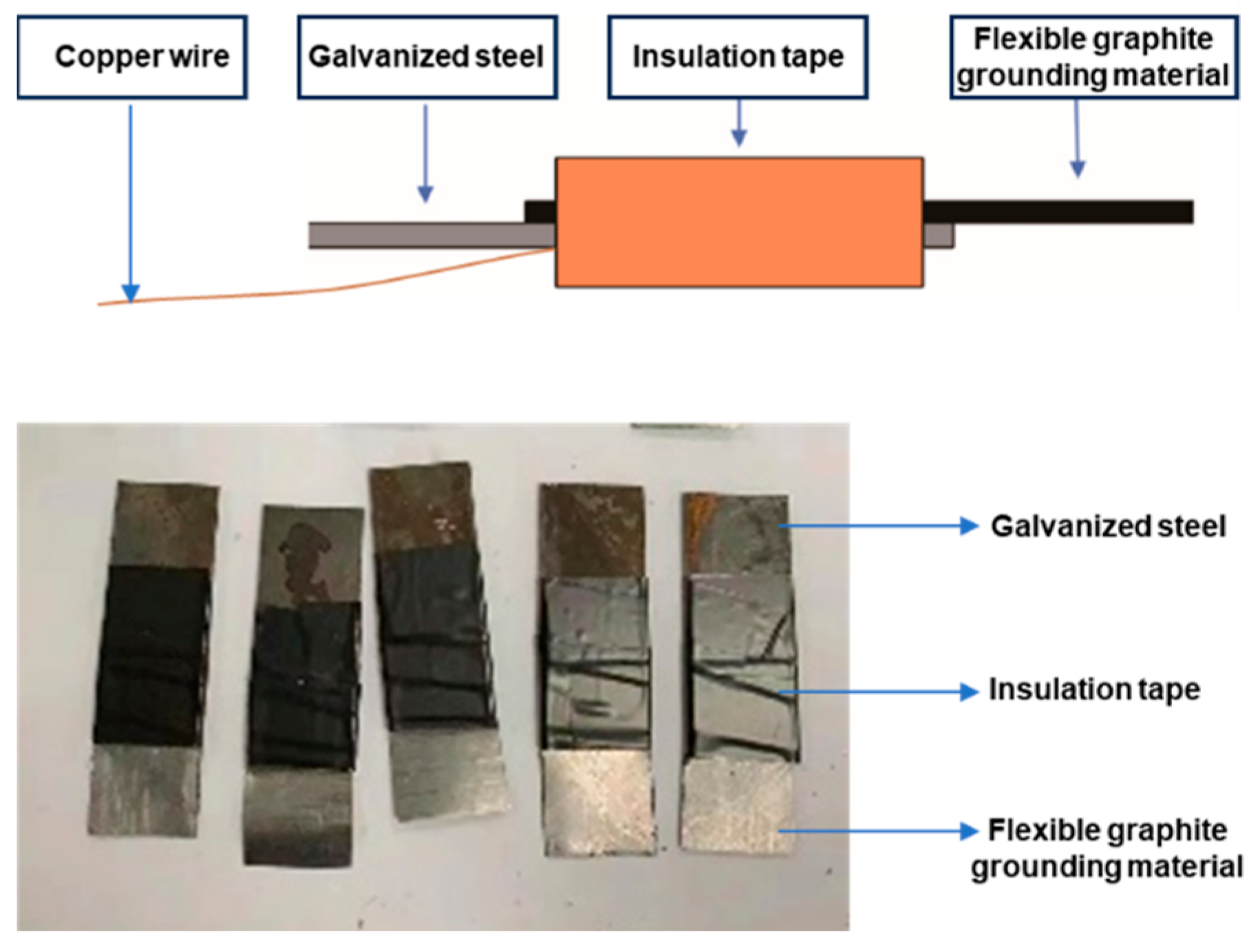
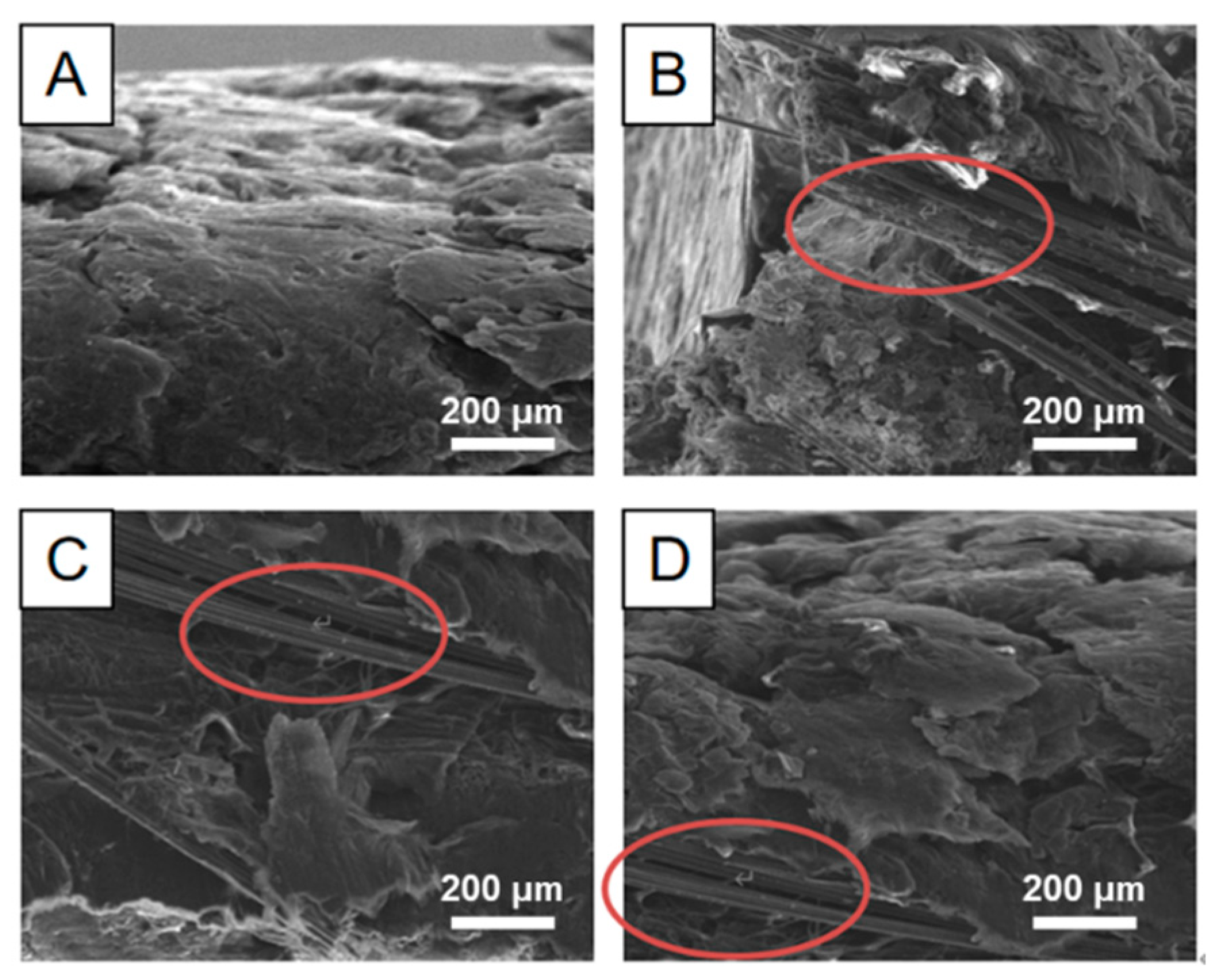

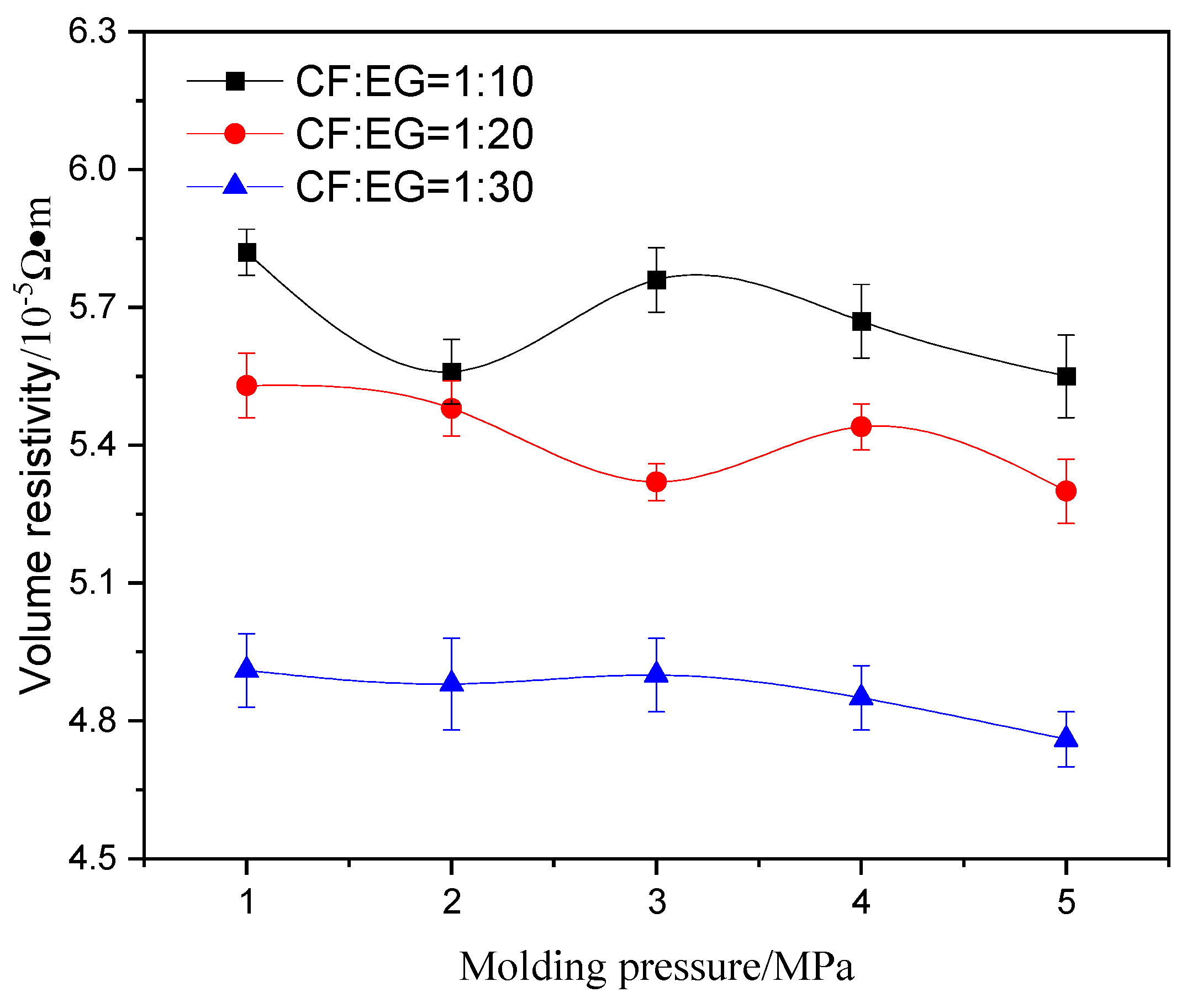
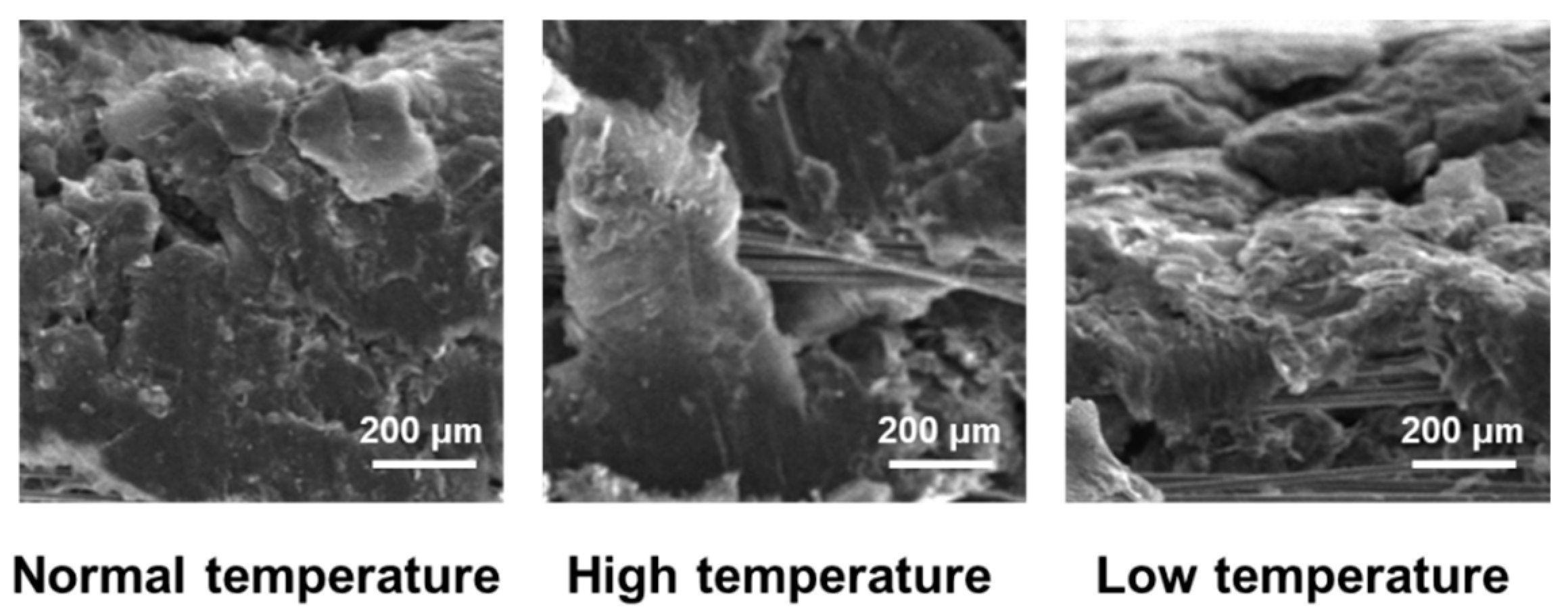
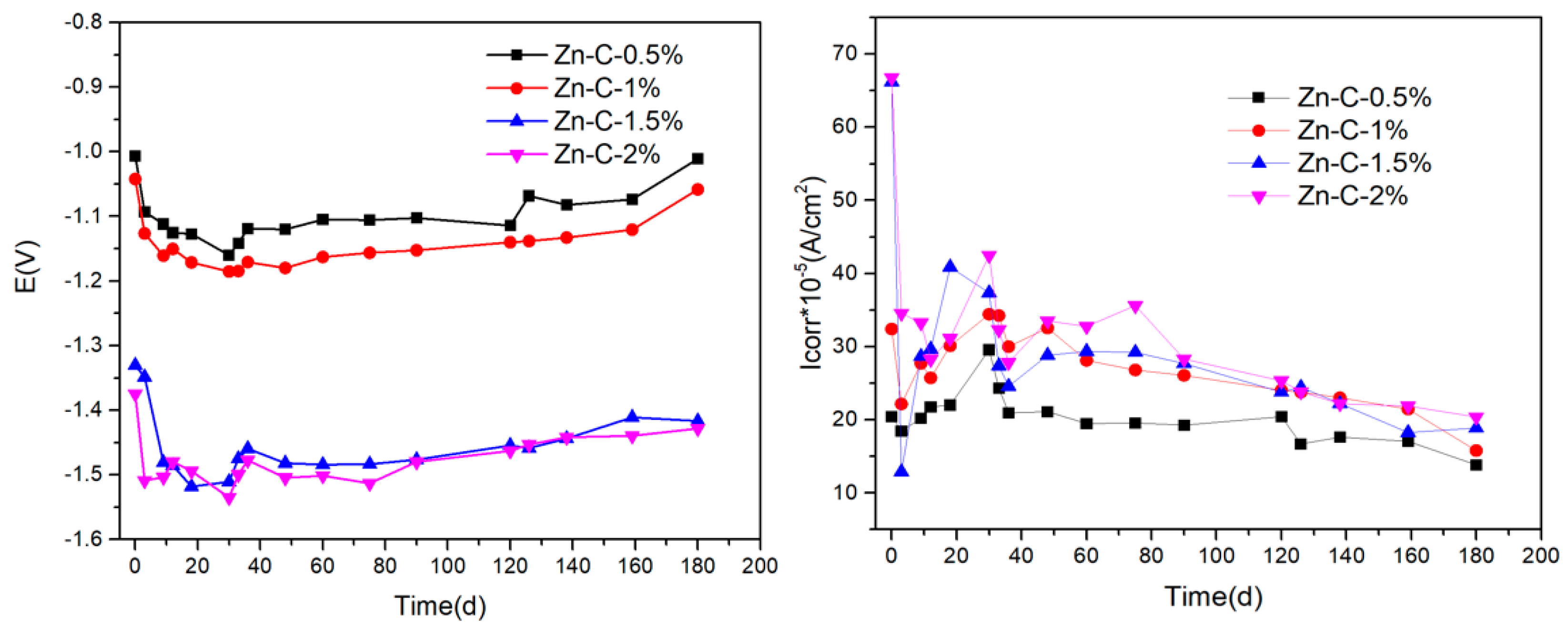

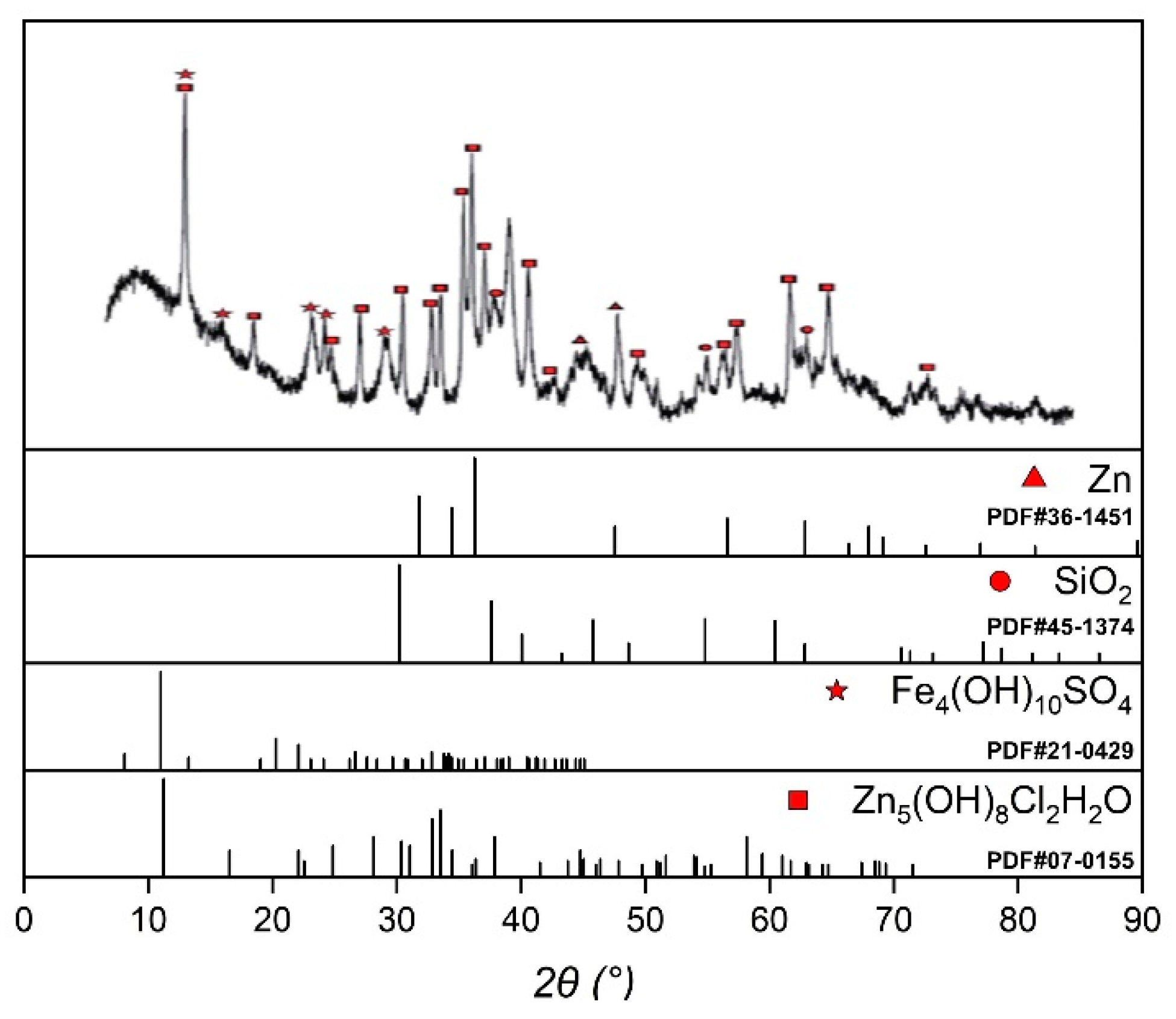
| No. | Normal Temperature (MPa) | High-Temperature Treatment (MPa) | Low-Temperature Treatment (MPa) |
|---|---|---|---|
| 1 | 5.5 | 5.0 | 5.5 |
| 2 | 5.4 | 4.9 | 5.3 |
| 3 | 4.9 | 4.7 | 4.6 |
| 4 | 5.4 | 4.9 | 5.1 |
| 5 | 5.3 | 5.0 | 5.1 |
| No. | Normal Temperature (10−5 Ω·m) | High-Temperature Treatment (10−5 Ω·m) | Low-Temperature Treatment (10−5 Ω·m) |
|---|---|---|---|
| 1 | 5.60 | 6.15 | 5.94 |
| 2 | 5.67 | 6.45 | 6.02 |
| 3 | 5.49 | 7.28 | 5.84 |
| 4 | 5.21 | 6.87 | 6.15 |
| 5 | 5.12 | 6.25 | 5.71 |
| Coupling Metal | Potential and Current Density | Concentration of SO42− | |||
|---|---|---|---|---|---|
| 0.5% | 1% | 1.5% | 2% | ||
| Galvanized steel | Galvanic potential /V | −1.01 | −1.04 | −1.33 | −1.38 |
| Couple current density /(μA·cm−2) | 20.46 | 32.42 | 66.20 | 66.81 | |
| Self-etching potential /V | −1.24 | −1.34 | −1.43 | −1.44 | |
| Self-etching current density /(μA·cm−2) | 6.70 | 7.40 | 9.18 | 10.49 | |
Disclaimer/Publisher’s Note: The statements, opinions and data contained in all publications are solely those of the individual author(s) and contributor(s) and not of MDPI and/or the editor(s). MDPI and/or the editor(s) disclaim responsibility for any injury to people or property resulting from any ideas, methods, instructions or products referred to in the content. |
© 2024 by the authors. Licensee MDPI, Basel, Switzerland. This article is an open access article distributed under the terms and conditions of the Creative Commons Attribution (CC BY) license (https://creativecommons.org/licenses/by/4.0/).
Share and Cite
Fan, M.; He, H.; Wang, L.; Wang, X.; Tan, B. Preparation and Properties of Carbon Fiber/Flexible Graphite Composite Grounding Material. Materials 2024, 17, 4838. https://doi.org/10.3390/ma17194838
Fan M, He H, Wang L, Wang X, Tan B. Preparation and Properties of Carbon Fiber/Flexible Graphite Composite Grounding Material. Materials. 2024; 17(19):4838. https://doi.org/10.3390/ma17194838
Chicago/Turabian StyleFan, Mian, Huiwen He, Lei Wang, Xianghan Wang, and Bo Tan. 2024. "Preparation and Properties of Carbon Fiber/Flexible Graphite Composite Grounding Material" Materials 17, no. 19: 4838. https://doi.org/10.3390/ma17194838





